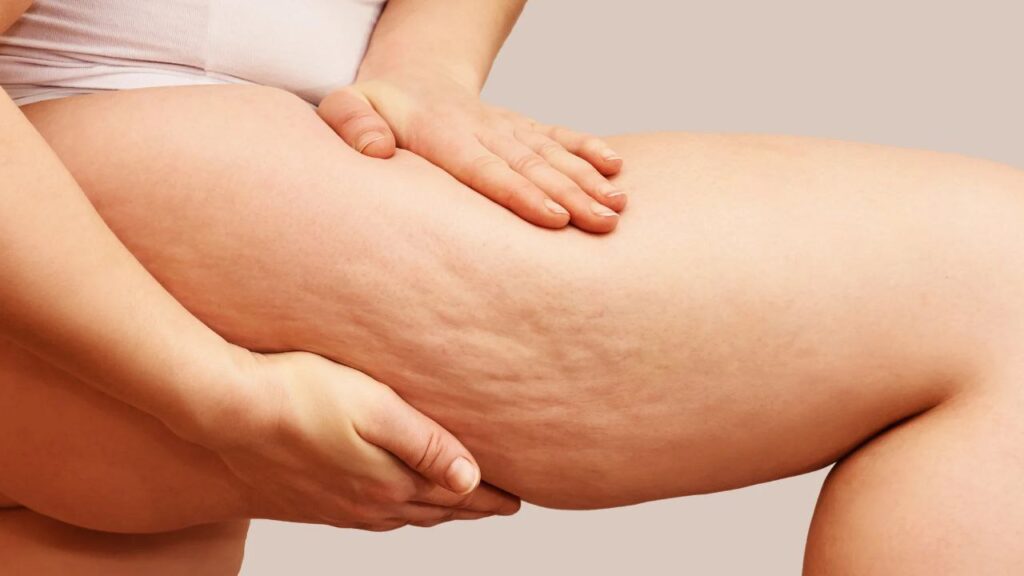The unsightly dents on the thighs and bottom are almost a “normal” part of our social image of women. So is this a normal process that is part and parcel of getting older? Definitely not. If you look at primitive peoples, you will not find cellulite, menopausal symptoms or acne. So where does this widespread phenomenon come from?
The hidden messages behind the dents
Cellulite is caused by a combination of slagging, unstable supporting tissue and an imbalance in the body’s fatty tissue. All three components have underlying causes that cannot be adequately treated by conventional medicine or in some cases cannot be measured using standard laboratory values. Let’s take a look at slagging as the first component.

Help – half my body is made of waste!
In fact, in some people the slagging can be so severe that 50% of the body consists of slag. With appropriate professional treatment, this can result in significant weight loss. Waste products are flushed out and healthy, stable tissue is built up in their place. So not only do the dents disappear, but the body also takes on a naturally beautiful shape.
But where do all the slags come from? They are caused by the binding of acids. Normally, the bound and thus neutralized acids are quickly excreted from the body. However, if the body has other construction sites on which it is focused or no longer has sufficient energy reserves, the acids are neutralized and thus rendered harmless for the time being, but the body saves the energy it would have to expend on disposal in favour of other processes.
There are three different storage areas where the waste products are deposited. The first store is blood and lymph. When this is full, the excess is stored in the uterus. Incidentally, this can also make it difficult for an egg to implant and is therefore an issue for women with an unfulfilled desire to have children. Once this store is also full, they are stored in the buttocks and thighs as a last resort. Until sufficient energy reserves are available for disposal.

The flood of acids has various causes. The most common is a dysfunction of the stomach. This can be asymptomatic or manifest itself through signs such as heart stumbling, frequent clearing of the throat, mucus in the morning, chronic sinusitis, tooth decay, asthma, flatulence, bloating, diarrhea or constipation.
Alkaline nutrition is NOT a solution
If the stomach is dysfunctional in this way, an alkaline diet will not help. This is because it cannot remedy the putrefactive processes in the stomach, but instead rots and produces acids, just like any other diet. Professional support is needed here.
Gastric dysfunction mainly produces sulphuric acids in the digestive system. But there are other factors that produce acids. Stress, for example, produces hydrochloric acids, lack of exercise leads to an increase in carbonic acid, anxiety and anger also lead to an increased production of hydrochloric acids. Things such as stress management, exercise and mental regulation can help to some extent, but the focus should be on the stomach.
A step towards initial self-help
Basically, it is always important to correct the causes. However, VitalBase from the Dr. Reinwald Shop can be used as a first step towards a better acid-base balance (voucher code: GesundheitSusann). In contrast to other preparations that have an effect on the acid-base balance, this one also contains apple pectin, which helps with gentle elimination. It is important not to stimulate detoxification, as this is contraindicated in many diseases.
Cells without support and structure
The second component in the full picture of cellulite is the loss of connective tissue structure. This can have different causes. The most common cause is a deficit in the energy balance. Indications of this are exhaustion, tiredness, lack of energy, concentration problems or even illnesses such as migraines, fatigue or fibromyalgia.

If the body no longer has enough energy for essential processes, it draws it from its reserves. In other words, it taps into connective tissue, hair, skin, nails, cartilage, bones or muscles, breaks them down and converts them into energy. The causes that led to the collapse of a well-functioning energy balance should be investigated in depth.
The fairy tale of greasy food
In the third component, too many fat cells, fatty food actually plays no role. This is because fat cells are not created by fat from food. Of course, the fats we eat should be healthy fats. These include, for example, ghee, which can be used for frying, a little high-quality butter or MCT oil. Ghee in particular is a good support for the remineralization of the body.
Too many fat cells can also be due to a disturbance in the energy metabolism. The causes should be clarified individually in order to create a functioning overall concept for a healthy body and legs without annoying dents.